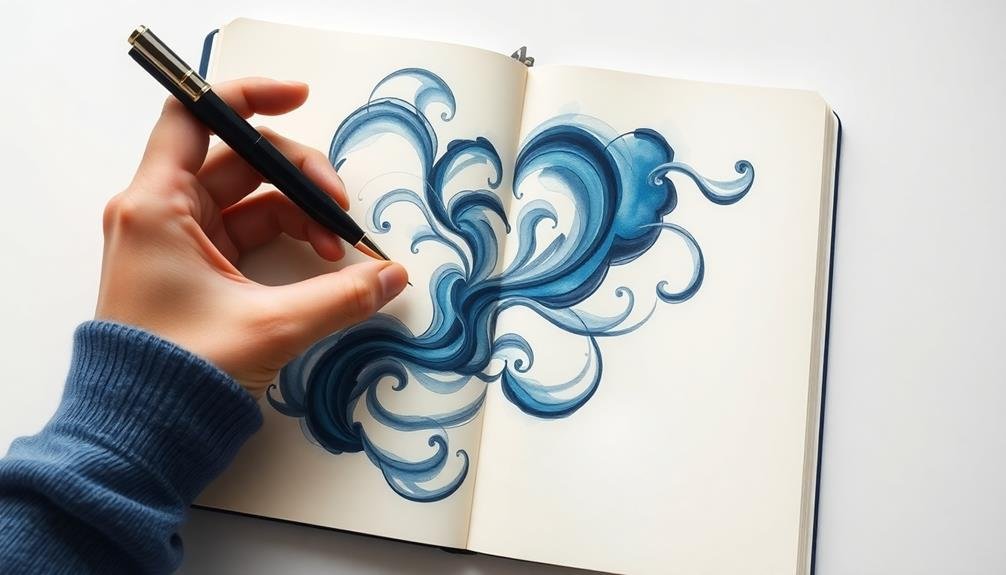Three effective mindful journaling techniques can help you ease anxiety and promote mental well-being. First, try stream of consciousness writing, where you write without censoring your thoughts for 10-15 minutes. This taps into your subconscious and helps identify hidden concerns. Second, practice gratitude journaling by regularly noting things you're thankful for, cultivating a positive mindset. Finally, use the worry dump exercise to write down your anxieties without judgment, creating mental space to process them objectively. These techniques allow you to explore your thoughts, reframe experiences, and symbolically let go of worries. Discover how these methods can transform your mental landscape and reduce stress.
Stream of Consciousness Writing

Stream of consciousness writing is one of the most liberating journaling techniques you'll encounter. It involves putting pen to paper and writing whatever comes to mind without censoring or editing your thoughts. This method allows you to tap into your subconscious and explore your deepest feelings and ideas.
To practice stream of consciousness writing, set a timer for 10-15 minutes and start writing. Don't stop to correct grammar or spelling, and don't worry about making sense. Let your thoughts flow freely onto the page. If you get stuck, simply write "I don't know what to write" until new ideas emerge.
This technique can help you identify hidden anxieties and concerns you may not have been aware of. It's also an excellent way to clear your mind and reduce stress.
As you write, you might discover patterns in your thinking or uncover solutions to problems you've been grappling with.
Gratitude Journaling
Gratitude journaling stands out as a powerful practice for cultivating a positive mindset and enhancing overall well-being. This technique involves regularly writing down things you're thankful for, shifting your focus to the positive aspects of life. To start, set aside a few minutes each day to reflect on what you appreciate.
Begin by listing three to five things you're grateful for, big or small. These could range from a delicious meal to a supportive friend or a beautiful sunset. Be specific and elaborate on why you're thankful for each item. As you continue this practice, you'll likely find it easier to identify positive elements in your daily life.
Consider varying your approach to keep the exercise fresh. Some days, focus on people you're grateful for; other times, concentrate on personal achievements or simple pleasures. You can also challenge yourself to find gratitude in difficult situations, which can help reframe negative experiences.
Worry Dump Exercise

A powerful technique for managing anxiety and clearing your mind is the worry dump exercise. This method involves setting aside dedicated time to write down all your worries, concerns, and anxious thoughts without censoring or judging them.
By putting your worries on paper, you're externalizing them and creating mental space to process them more objectively.
To practice the worry dump exercise, find a quiet place where you won't be interrupted. Set a timer for 10-15 minutes and start writing. Don't worry about grammar, spelling, or coherence; just let your thoughts flow freely onto the page.
Write down everything that's causing you stress or anxiety, no matter how big or small.
Once you've finished, take a moment to review what you've written. You may notice patterns or recurring themes. This awareness can help you identify areas where you need to focus your energy or seek support.
After completing the exercise, you can choose to keep your writing for future reflection or dispose of it as a symbolic act of letting go of your worries.
Frequently Asked Questions
How Often Should I Practice Mindful Journaling for Optimal Anxiety Relief?
You should aim to practice mindful journaling daily for ideal anxiety relief. Even 5-10 minutes can make a difference. Consistency is key, so find a time that works best for you and stick to it. You'll see better results with regular practice.
Can Mindful Journaling Replace Professional Therapy for Anxiety Disorders?
While mindful journaling can be a helpful tool, it shouldn't replace professional therapy for anxiety disorders. You'll benefit most from combining journaling with therapy, as a therapist can provide expert guidance and treatment tailored to your specific needs.
What's the Best Time of Day to Engage in Mindful Journaling?
You'll find the best time for mindful journaling is when you're most relaxed and free from distractions. Try early mornings for clarity, or evenings to reflect on your day. Consistency matters more than the specific hour.
Are There Any Potential Negative Effects of Mindful Journaling?
While mindful journaling is generally beneficial, you might experience temporary discomfort when confronting difficult emotions. You could also become overly self-critical or obsessive about your thoughts. It's important to maintain balance and seek support if needed.
How Long Should Each Mindful Journaling Session Typically Last?
You'll want to aim for 10-20 minutes per session, but don't stress about timing. It's more important that you're consistent and comfortable. If you're new, start with 5 minutes and gradually increase as you build the habit.
In Summary
You've now learned three powerful journaling techniques to manage anxiety. By incorporating stream of consciousness writing, gratitude journaling, and worry dump exercises into your routine, you'll gain clarity, focus on positives, and release pent-up concerns. Remember, consistency is key. Make journaling a daily habit, even if it's just for a few minutes. As you practice these methods, you'll likely notice a gradual reduction in anxiety and an increased sense of calm. Give yourself time and be patient with the process.





Leave a Reply